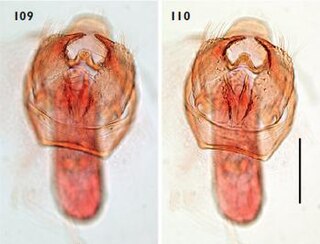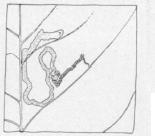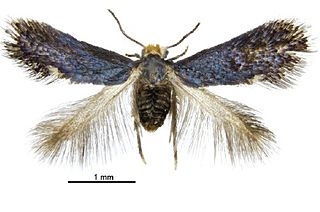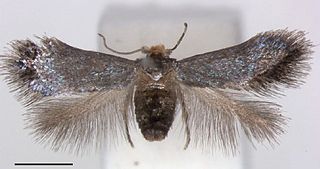
Stigmella ruficapitella is a moth of the family Nepticulidae. It is found in northern and central Europe. It is mostly absent in the Mediterranean region, with the exception of Mount Olympus in Greece and Trieste. It has recently been recorded from Russia and Bosnia.

Stigmella lapponica is a moth of the family Nepticulidae found in Asia, Europe and North America. It was first described by the German entomologist, Maximilian Ferdinand Wocke in 1862. The larvae mine the leaves of birch.

Stigmella salicis is a moth of the family Nepticulidae which is found in Europe. It was first described by the English entomologist, Henry Stainton in 1854. The type locality is from England.

Stigmella perpygmaeella is a moth of the family Nepticulidae, found in most of Europe, east to Russia. The larvae mine the leaves of hawthorns.

Ectoedemia subbimaculella is a moth of the family Nepticulidae. It is found in most of Europe, east to Smolensk, Kaluganorth and the Volga and Ural regions of Russia.

Ectoedemia spinosella is a moth of the family Nepticulidae. It is found in southern Europe, reaching in the north to the southern part of Great Britain, the Netherlands, central Germany and Poland. It has also been recorded from the Crimea, the Caucasus and the European part of the former Soviet Union. It is common in western Turkmenistan.
Ectoedemia mahalebella is a moth of the family Nepticulidae. It is found from the Czech Republic and Slovakia to the Pyrenees, Italy and Greece.

Acalyptris minimella is a moth of the family Nepticulidae. It is widespread and common in the western Mediterranean region, usually not far from the sea. It has been recorded from Portugal, Spain, France, Italy, Croatia, Ibiza, Mallorca, Corsica, Sardinia and Sicily. It is also present in North Africa, where it has been recorded from Morocco, Algeria and Tunisia.

Acalyptris pistaciae is a moth of the family Nepticulidae. It is found in the eastern Mediterranean region, where it is widespread in Greece, Cyprus and Turkey. It is probably also present in Syria and Lebanon. Mines collected in Israel in 1931 and identified as Simplimorpha promissa may also belong to be this species.
Stigmella nakamurai is a moth of the family Nepticulidae. It is only known from Hokkaido in Japan.

Stigmella flavipedella is a moth of the family Nepticulidae. It is found in Ohio and Kentucky in the United States.
Trifurcula ortneri is a moth of the family Nepticulidae. It is widespread in the western Mediterranean region, where it is known from the Algarve in Portugal, Spain, France and Italy. It has also been recorded from Croatia (Dalmatia), Morocco and Algeria, eastern Austria, Hungary, Slovakia and Germany.
Stigmella montanotropica is a moth of the family Nepticulidae. It is found in tropical montane forest on the western slopes on the Andes in Ecuador.
Stigmella rubeta is a moth of the family Nepticulidae. It is found in tropical montane forest of the western slopes of the Andes in Ecuador.

Pectinivalva brevipalpa is a moth of the family Nepticulidae. It is found in New South Wales.

Pectinivalva minotaurus is a moth of the family Nepticulidae. It is found in southern Queensland.

Pectinivalva scotodes is a moth of the family Nepticulidae. It is found in New South Wales and southern Queensland.

Pectinivalva acmenae is a moth of the family Nepticulidae. It is found in New South Wales.

Pectinivalva quintiniae is a moth of the family Nepticulidae. It is found in northern New South Wales and southern Queensland.

Pectinivalva tribulatrix is a moth of the family Nepticulidae. It is found in northern Queensland.
















